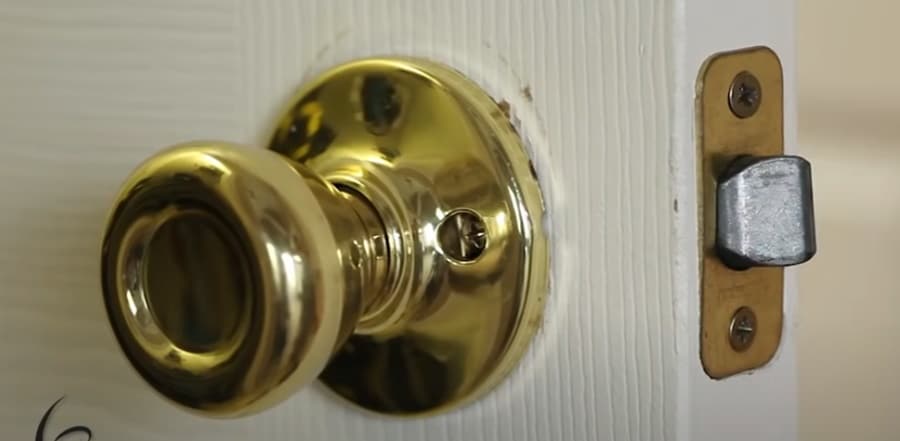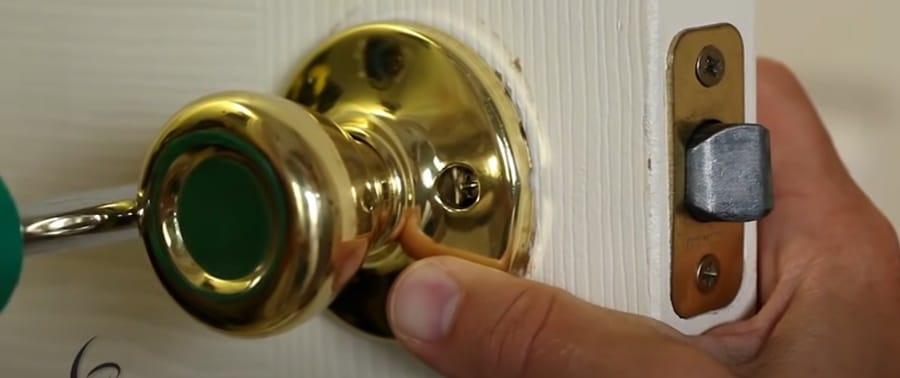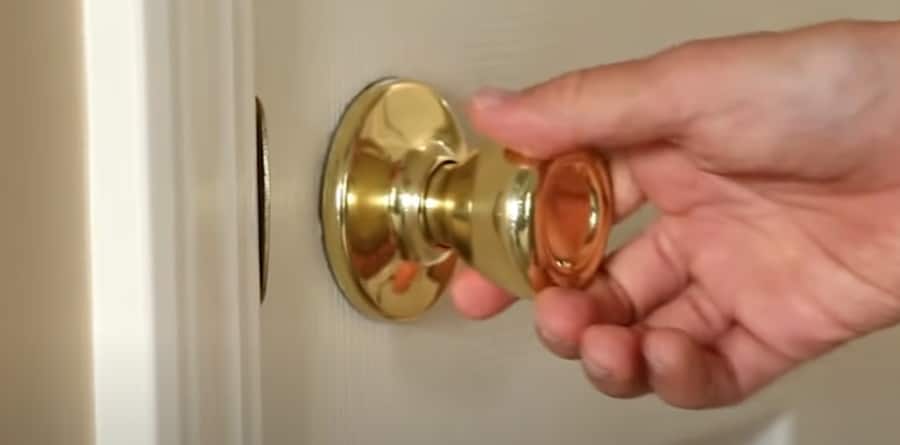Door Latch Stuck in Locked Position: A Simple Step-by-Step Guide
We’ll offer useful tips and ways to get back into your house when your house front door won’t open from inside or outside when you turn your key.
A door latch stuck in the locked position can be a frustrating and inconvenient issue for any homeowner or business owner. Such a problem hampers your ability to access the space and raises security concerns.
This article will explore the common reasons behind a door latch getting stuck in the locked position, offer practical troubleshooting tips, and suggest preventative measures to avoid future occurrences.
Why is the door latch stuck in the locked position?

A door latch can get stuck in the locked position for several reasons, such as:
- Misaligned door or strike plate: If the door or the strike plate is misaligned, the latch can become stuck in the locked position. This may be due to the door warping over time, the house settling, or improper installation.
- Dirt or debris in the latch: Dirt, dust, or debris can accumulate over time and cause it to get stuck.
- Worn-out latch or lock mechanism: Over time, the latch or lock mechanism can wear out, causing it to get stuck in the locked position.
- Jammed locking mechanism: The lock within the door latch can sometimes become jammed, preventing the latch from unlocking.
- Frozen or rusted latch: In cold climates or high-humidity environments, the latch can freeze or become rusted, causing it to get stuck in the locked position.
- Warped Door: Doors can warp for various reasons, including moisture, temperature fluctuations, and improper installation.
To determine the specific cause of your door latch getting stuck, you may need to inspect the latch, lock mechanism, and door alignment to identify the issue and apply the appropriate solution.
How to fix a door latch stuck in the locked position?

To fix a door latch stuck in the locked position, follow these steps:
Step 1: Inspect the door alignment
Check if the door is properly aligned with the frame and strike plate. Look for gaps or misalignment that may be causing the latch to get stuck. If misaligned, adjust the strike plate by loosening the screws, shifting it into the proper position, and tightening the screws.
Step 2: Check the Door Hinges
Loose or worn-out door hinges can cause the door to sag, leading to misalignment with the latch and strike plate. Inspect the door hinges for wear or damage, and tighten loose screws. If the hinges are severely worn or damaged, they may need to be replaced.
Step 3: Examine the door handle and spindle.
Inspect the handle for any looseness or damage. Also, ensure the spindle connecting the door handle to the latch is properly aligned and securely fastened.
Step 4: Check the key and lock cylinder.
If you’re having trouble with a keyed lock, inspect the key for signs of wear or damage. Also, check the lock cylinder for debris or obstructions that could be causing the key to not turn smoothly.
Step 5: Tighten the screws
Check the screws on the door handle, latch, and strike plate. If they are loose, tighten them to ensure the proper alignment and function of the latch.
Step 6: Remove the lock mechanism.
Carefully remove it from the door by unscrewing it and examining it for damage or wear. This will allow you to identify the cause of the problem and determine if any parts need repair or replacement.
Step 7: Adjust the spindle
If the spindle connecting the door handle to the latch is loose or misaligned, adjust it by tightening any screws or repositioning it within the lock mechanism.
Step 8: Lubricate the door latch.
To ensure smooth operation, apply a suitable lubricant, such as silicone spray or graphite powder, to the latch and lock mechanism.
Step 9: Remove dirt or debris.
Clean the latch and lock mechanism using a brush or compressed air to remove any accumulated dirt or debris causing the latch to get stuck.
Step 10: Realigning the Door Latch
Sometimes, the latch itself might need adjustment. You can do this by loosening the screws holding the latch in place, realigning it with the strike plate, and then tightening the screws.
Step 11: Replacing the Door Latch
If the internal mechanism is damaged or worn out, you may need to replace the entire door latch. Remove the old latch and take it to a hardware store for a suitable replacement. Install the new latch according to the manufacturer’s instructions, ensuring proper alignment with the strike plate.
Step 12: Try unlocking the door.
After addressing the issues, try unlocking the door with the key or turning the door handle. If the latch still does not disengage, re-examine the lock mechanism and door alignment to identify any further issues.
Step 13: Call a Professional
If you cannot fix the door latch or are uncomfortable working with locks, consider calling a professional locksmith to diagnose and repair the issue.
Remember to work cautiously and follow any safety precautions when working with door locks and latches to avoid damaging your door.
To learn more about fixing a Stuck Door Latch, please check the following video:
How to Fix a Stuck Door Latch?
How to avoid the door latch stuck in the locked position
To avoid a door latch getting stuck in the locked position, follow these preventative measures:

- Regular maintenance: Inspect and clean the latch, lock mechanism, and door hardware. Remove dirt, dust, and debris using a brush or compressed air, and lubricate the latch and lock mechanism with a suitable lubricant such as silicone spray or graphite powder.
- Proper installation: Ensure the door, latch, and lock mechanism are correctly installed and aligned. Follow the door lock manufacturer‘s instructions for installation and make any necessary adjustments to the door hinges, strike plate, and lock mechanism to maintain proper alignment.
- Monitor door alignment: Keep an eye on the door alignment over time, as doors can warp or houses can settle, leading to misalignment. Adjust the strike plate, door hinges, or door frame to maintain proper alignment and prevent the latch from getting stuck.
- Inspect for wear and tear: Regularly examine the latch and lock mechanism for signs of wear or damage. Replace any worn or damaged parts as needed to maintain the latch and lock’s proper function.
- Protect against rust and corrosion: In humid or coastal environments, apply a rust inhibitor or protectant to the latch and lock mechanism to help prevent rust and corrosion. Keep the door dry and well-ventilated to reduce the risk of rust formation.
- Prevent freezing: In cold climates, install weather stripping and insulation around the door to minimize the risk of the latch freezing. If you anticipate a freeze, consider applying a de-icing spray to the lock and latch before the temperature drops.
- Use quality hardware: Opt for high-quality hardware from reputable manufacturers when installing or replacing a door latch or lock mechanism. Quality components are less likely to malfunction or wear out prematurely, reducing the risk of the latch getting stuck in the locked position.
- Avoid slamming doors: Slamming doors can damage the latch, lock mechanism, and door alignment. Encourage gentle door closing and consider installing door closers or soft-close mechanisms to reduce the impact on the latch and lock.
By following these preventative measures, you can minimize the risk of your door latch getting stuck in the locked position and maintain the proper function of your door lock system.
Conclusion
In summary, a door latch stuck in the locked position can be caused by various factors, including misaligned components, worn-out parts, or a lack of maintenance. You can resolve the issue by identifying the root cause, applying the appropriate troubleshooting techniques, and restoring your door latch to proper working order.

